| Columns Retired Columns & Blogs |
AudioValve Baldur 70 monoblock power amplifier Measurements
Sidebar 3: Measurements
As is my usual practice, I preconditioned the Baldur 70 by running the amp at 1/3 power into 8 ohms for an hour before performing any measurements. Via the Baldur's unbalanced (RCA) input jack, its voltage gain at 1kHz into 8 ohms was a high 31.55dB from the 8 ohm output transformer tap, 28.45dB from the 4 ohm tap. Unusually, the gain via the balanced (XLR) jack was 6dB lower from both taps. As the amplifier was noninverting via both inputs, the difference in gain suggests that the balanced input isn't truly balanced, but simply has pin 3 of the jack tied to ground. The unbalanced input impedance ranged from 39k ohms at 20kHz to 58k ohms at 1kHz, both figures usefully high. The balanced input impedance was significantly lower, however, at 11.3–13.4k ohms depending on frequency.
The Baldur's output impedance, from both the 8 and 4 ohm transformer taps, was lower than usual for a tubed amplifier, at 0.66 and 0.42 ohm, respectively. These figures were measured at 20Hz and 1kHz; the 20kHz figures were slightly but inconsequentially higher. As a result, the modification of the amplifier's frequency response with our simulated speaker remained between ±0.3dB limits using the 4 ohm tap (fig.1, top trace at 2kHz). This increased slightly from the 8 ohm tap, to ±0.5dB. Fig.1 also shows that the amplifier's bandwidth is reasonably wide into higher impedances, not reaching its –3dB point until 61kHz into 8 ohms from both taps. The bandwidth did decrease into lower impedances, however, the response into 2 ohms from the 4 ohm tap dropping by 1dB at 20kHz. The amplifier's reproduction of a 10kHz squarewave had correspondingly rounded leading edges, with a small degree of damped overshoot visible into higher impedances (fig.2).
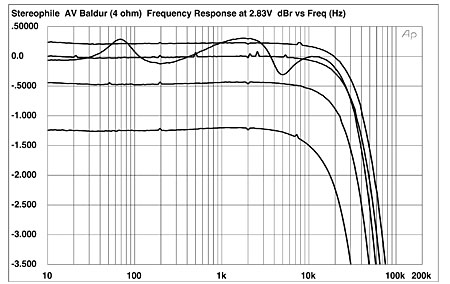
Fig.1 AudioValve Baldur 70, 4 ohm tap, frequency response at 2.83V into (from top to bottom at 2kHz): simulated loudspeaker load, 16, 8, 4, 2 ohms (0.5dB/vertical div.).
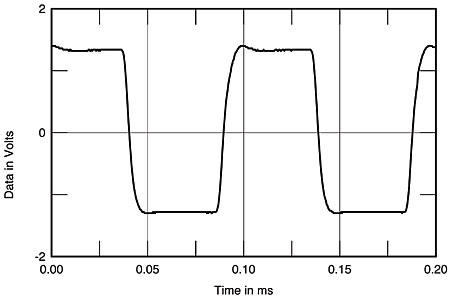
Fig.2 AudioValve Baldur 70, 8 ohm tap, small-signal 10kHz squarewave into 8 ohms.
Figs.3 and 4 plot how the percentage of distortion and noise in the Baldur's output changes with increasing output power, from the 8 and 4 ohm output taps, respectively, using a 1kHz tone. Though the amplifier offers respectably low distortion into the higher impedances at levels below a few watts, the THD increases significantly at high powers into both high and low impedances. The AudioValve doesn't meet its specified 70W (18.5dBW) output power at our usual 1% THD+noise figure, but does do so at 2% THD when the load is matched to the nominal transformer tap. However, even from the 4 ohm tap, the amplifier is considerably more linear at all power levels driving 8 and 16 ohm loads.
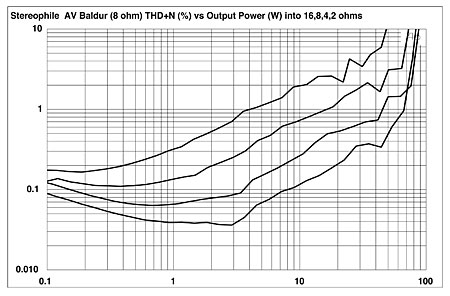
Fig.3 AudioValve Baldur 70, 8 ohm tap, distortion (%)vs 1kHz continuous output power into (from bottom to top at 100W): 16, 8, 4, 2 ohms.
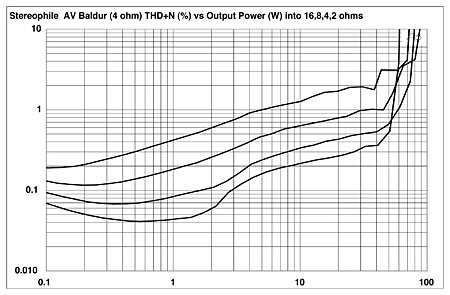
Fig.4 AudioValve Baldur 70, 4 ohm tap, distortion (%)vs 1kHz continuous output power into (from bottom to top): 16, 8, 4, 2 ohms.
The same thing is true when the Baldur's THD+N percentage is examined on a frequency basis (fig.5, 8 ohm tap; fig.6, 4 ohm tap). The distortion increases considerably into low impedances, but can also be seen to do so in the mid–high treble and the low bass. In the midrange, the distortion is predominantly the subjectively innocuous second harmonic (fig.7), which is the prime contributor to the higher percentages of distortion noted into lower impedances. At low frequencies, however, the increase in THD is due to the introduction of the third harmonic, presumably due to the output transformer's core beginning to saturate, even at relatively low powers (fig.8).
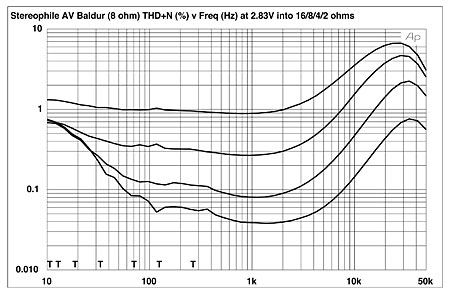
Fig.5 AudioValve Baldur 70, 8 ohm tap, THD+N (%)vs frequency at 2.83V into (from bottom to top): 16, 8, 4, 2 ohms.
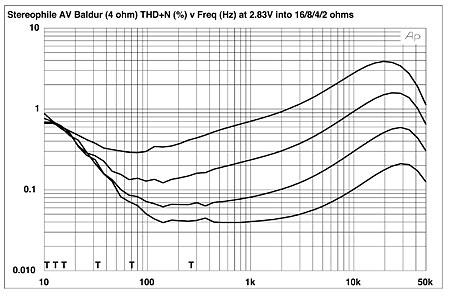
Fig.6 AudioValve Baldur 70, 4 ohm tap, THD+N (%)vs frequency at 2.83V into (from bottom to top at 100Hz): 16, 8, 4, 2 ohms.
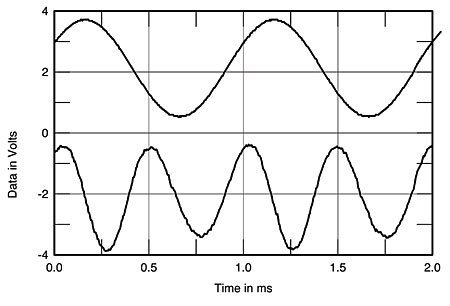
Fig.7 AudioValve Baldur 70, 4 ohm tap, 1kHz waveform at 1W into 4 ohms (top), 0.184% THD+N; distortion and noise waveform with fundamental notched out (bottom, not to scale).
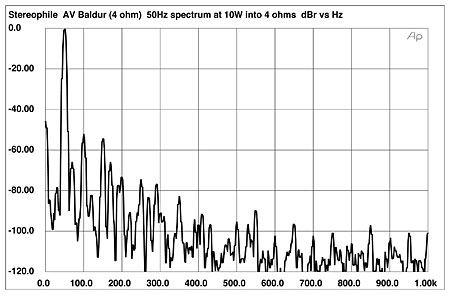
Fig.8 AudioValve Baldur 70, 4 ohm tap, spectrum of 50Hz sinewave, DC–1kHz, at 10W into 4 ohms (linear frequency scale).
I was also concerned by something else that can be seen in this graph: Despite the 120Hz power-supply component lying at a reasonably low –84dB (0.006%), a component can be seen at 70Hz, which is the difference frequency between 120Hz and the signal frequency of 50Hz. I couldn't eliminate this or the 120Hz, no matter how I arranged the grounding between the Baldur and my Audio Precision System One. Similarly, when I examined the amplifier's performance using an equal mix of 19kHz and 20kHz tones, a wealth of sidebands appear spaced 120Hz away on either side of the spectral lines representing the signal and the intermodulation components produced by the amplifier, even at powers well below the onset of visible waveform clipping (fig.9).
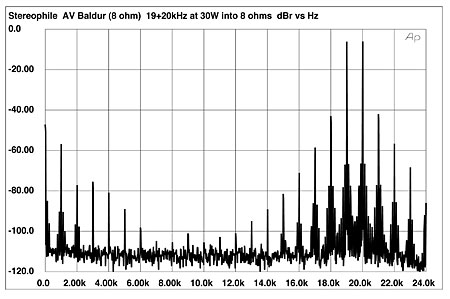
Fig.9 AudioValve Baldur 70, 8 ohm tap, HF intermodulation spectrum, DC–24kHz, 19+20kHz at 30W peak into 8 ohms (linear frequency scale).
The hum components limited the wideband, unweighted signal/noise ratio to a fairly modest 70.7dB (ref. 1W into 8 ohms from the 8 ohm tap), though A-weighting increased the ratio to a better 85.1dB.
While the AudioValve Baldur 70 offers a respectably low level of harmonic distortion and midband frequencies into higher impedances, it gets distinctly uncomfortable at the frequency extremes into lower impedances. I wonder if this measured behavior correlated with Michael Fremer's feeling that there was "an unremitting hardness in the upper midrange and top end," though the relatively poor intermodulation results would also contribute to this. Despite its fairly high specified power, the Baldur 70 will really sound at its best only with high-sensitivity, high-impedance speakers, I feel.—John Atkinson
- Log in or register to post comments



































